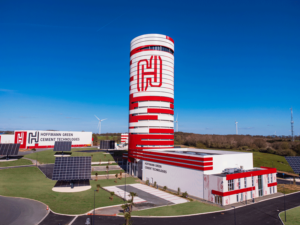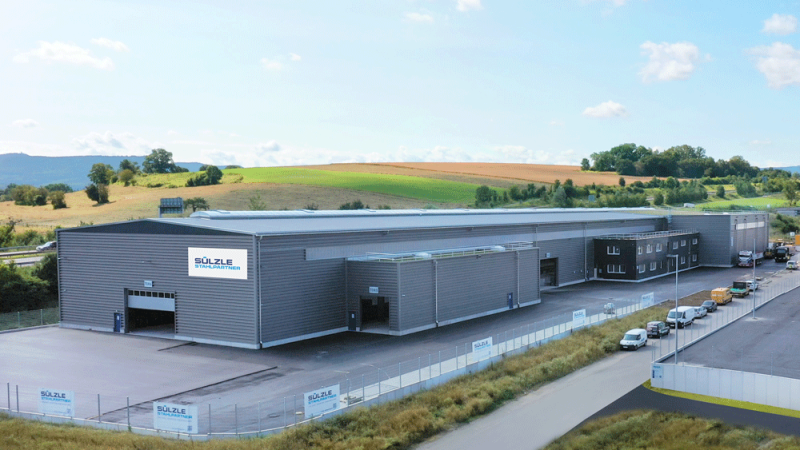The story of Hoffmann Green Cement Technologies started with a meeting in 2014 between two men with complementary skills who shared the same ambition: to help the construction industry become more environmentally friendly.
David Hoffmann, an experienced scientist, and Julien Blanchard, a true entrepreneur, set out to develop and manufacture new-generation cements on an industrial scale. Together with their dedicated team, they invented a genuine technological breakthrough based on the modification of the composition of cement and the creation of a cold manufacturing process, 0% clinker and low energy consumption, making their business a leading and unique player in the cement market, which had not changed for 200 years.
 Industry game changer
Industry game changer
Business Focus spoke to Thomas Atkinson, Head of International Affairs, about the remarkable progress the company has made and the impact its ‘green’ cement will have on the construction industry.
He explained that in 2022, Hoffmann Green Cement became the first clinker-free cement in the world to be validated under ATEx Case A by the CSTB, and the company is now the first European cement manufacturer to be 100% in line with Europe’s Green Taxonomy. “Cement is responsible for 8% of carbon emissions worldwide, and of this 8% around 85% is due to the clinker factor. Given its environmental implications, our clinker-free cement has generated considerable interest.”
The company currently offers four types of its clinker-free cement, each offering unique benefits. For example, its new product marketed as H-UKR cement reduces the carbon footprint of cement by a factor of 5, with the same or better performance. H-UKR cement is manufactured mainly from industrial by-products, in particular from steelworks slag, in order to preserve natural resources. According to the company, H-UKR is the only available low-carbon cement on the European market that achieves the structural requirements of traditional clinker concrete.
“However, the actual application does not come without serious hurdles,” noted Atkinson, pointing out that in this conservative industry, the traditional cement lobby is strong. “All the norms and standards are based on concrete made of traditional clinker-based cement, so this makes it difficult for our products to be accepted on a wide scale.”
“The norms were written, understandably, by clinker producers and are based on composition, not on performance. This will have to change, and we are intensively working on this, lobbying both at the industrial and EU levels.”
Strategic partnerships
However, distinct progress is already being made, as the focus on environmentally friendly technologies increases. Atkinson stated that Hoffmann’s concrete has already been certified in France and the company is set to expand internationally, following a clearly defined strategy. “The first step is to arrange distribution agreements to test the product in the markets. Ultimately, the main goal is to get partners to license the technology so that they can produce cement locally.”
Several distribution contracts have already been signed, including the very recent structuring partnership with POINT.P, a brand of Saint-Gobain Building Distribution France to distribute Hoffmann’s clinker-free H-UKR cement to the concrete mixing plants and precast factories of POINT.P.
In the UK, Hoffmann Green supplies Cemblend with its H-IONA, H-UKR and H-EVA clinker-free decarbonated cements for distribution to its customers in the UK and Ireland. This exclusive distribution agreement with volume commitments initially runs until the end of 2023 and is a first step towards the signature of a licencing agreement which could see Cemblend build and operate a production unit similar to Hoffmann Green’s second production site (H2), and then produce and market Hoffmann cements in the UK.
In terms of the actual licencing agreements, a milestone success was reached in September 2023: Hoffmann Green signed its first, 22-year exclusive licencing agreement in Saudi Arabia with the Shurfah Group to fund, construct and operate Hoffmann Green production units in Saudi Arabia. In early 2025, the first clinker-free cement factory, modelled after the H2 vertical model, will be operated in Saudi Arabia.
 Unique in the world
Unique in the world
What is Hoffmann’s H2 vertical model? This is another game changer that the company has introduced with regard to the production process. Looking back, the company’s first 4.0 production site H1 which was inaugurated in the Vendée region in France in 2018, was already one of a kind – with no kiln nor chimney, it produces no waste and is based on an automated industrial production process.
Hoffmann Green’s second H2 facility, the world’s first vertical cement plant, was inaugurated in May 2023. Built in less than 24 months and made entirely with H-UKR clinker-free concrete, this new production model is an example of innovative, forward-looking thinking, ‘a feat of civil engineering’ to quote the company.
A vertical structure limits the physical footprint and also makes it possible to use gravity (as opposed to conveyor belts) to optimize the production process and make it less energy consuming. The installation of 12 solar trackers makes the plant over 50% self-sufficient in energy. The plant has been designed to be adapted and replicated throughout France and the world.
Catalyst of carbon transition
Thomas Atkinson confirmed that Hoffmann’s third manufacturing facility, located at Dunkirk Major Sea Port, is planned to be operational in 2026, enabling Hoffmann Green to reach a production capacity of 550,000 tonnes of cement per year by 2026, which would represent 3% of the French market.
“There are other types of alternatives to replace the traditional carbon-heavy products in the construction industry but most of these technologies are in the start-up phase. Our products are ready and immediately available. That’s a major advantage.”
“The key task now is to convince all the players in the construction industry to move to other types of technologies, a mammoth task, given the industry’s conservatism. Still, times do seem to be changing, albeit slowly.”
He affirmed that interest in Hoffmann’s technology is increasing around the world, accentuated by the increased push for sustainable, energy-efficient solutions and pressure on construction players to use more low-carbon cements. In this context, the company is well positioned to reach its targets, in both France and the international markets.







